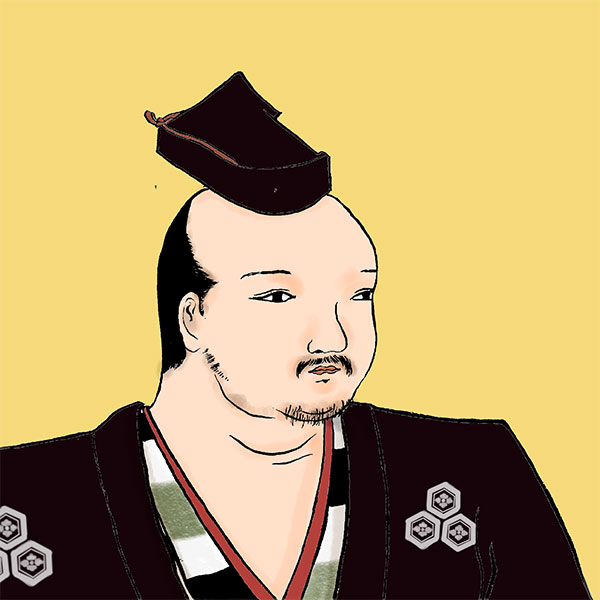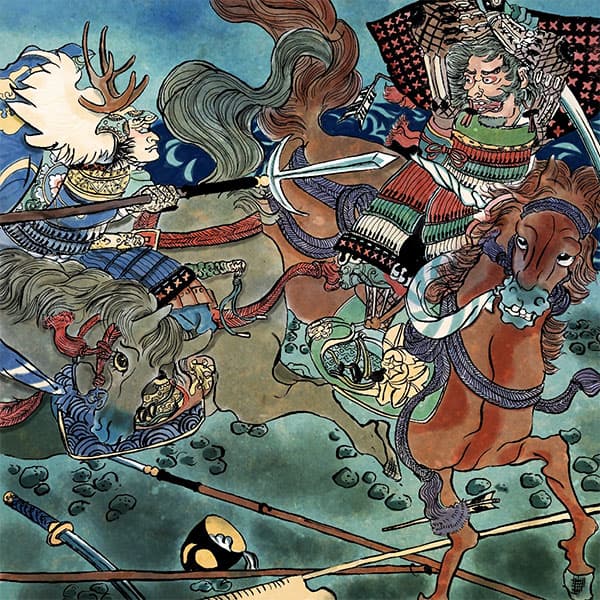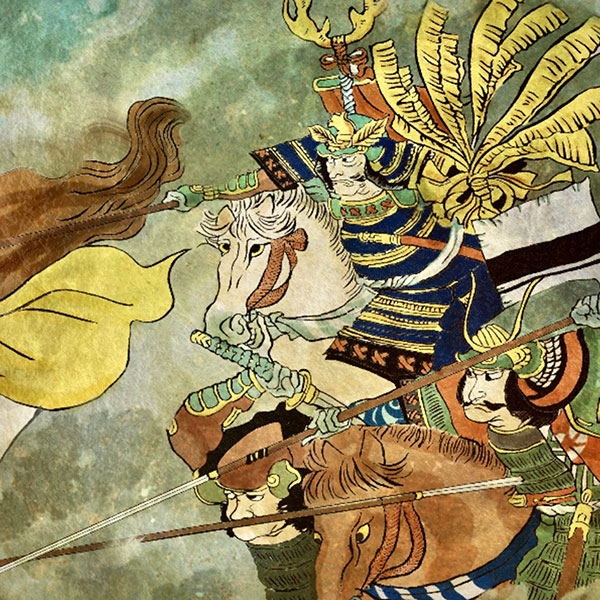Nagamasa Asai (2/2)The last head of the Asai family in Kitaomi

Nagamasa Asai
- Article category
- biography
- name
- Nagamasa Asai (1545-1573)
- place of birth
- Shiga Prefecture
- Related castles

Ichijodani Asakura Residence
- related incident
Nobunaga found himself in a predicament due to Nagamasa's unexpected betrayal, but through the efforts of Kinoshita Tokichiro (later Toyotomi Hideyoshi), who served as the lord, he managed to retreat (Battle of Kanegasaki).
Regarding this betrayal, Nobunaga said that he did not understand the reason at first and dismissed it as ``Maybe it was a lie,'' but even now the reason for this betrayal remains unclear.
It is often said that the alliance with the Asakura clan was important, but this theory has its origins in a work of fiction from the Edo period, and academically it is said that the alliance with the Asakura clan was important before this betrayal. Its existence has been denied throughout the Ryomasa and Hisamasa eras. However, regarding this issue, as mentioned above, there is a theory that the relationship between the two clans was only established when Nagamasa entered into a subordinate relationship with Yoshikage when he became independent from the Rokkaku clan, and some parts are still unclear. There is.
The main military commanders did not participate in the march to Tsuruga, and there is no record that Nagamasa was present. There is also a theory that there was no alliance between the Oda and Azai in the first place, and that the Oda army at the Battle of Kanegasaki learned of the Asai clan's raising of an army while returning in triumph after achieving its goal.
On the other hand, there is also a theory that this battle itself was based on a subjugation order from Yoshiaki Ashikaga, who had a deepening conflict with Yoshikage over control of Wakasa Province, so he had no choice but to follow the shogun's orders. From Nobunaga's perspective, Nagamasa's actions could be seen as unreasonable.
In June of the same year, Nagamasa and the Asakura army fought against the Oda and Tokugawa allied forces in Anegawa, Omi Province (Battle of Anegawa). In the end, the battle ended in victory for the Oda-Tokugawa allied forces. Furthermore, Takatora Todo, who was an ashigaru of the Asai army at the time, took part in the Battle of Anegawa, achieved military exploits against the Oda army, and received a letter of commendation from Nagamasa.
After the Battle of Anegawa, the Miyoshi Sanninshu and Honganji Temple, who felt threatened by Nobunaga, raised troops (Battle of Noda Castle and Fukushima Castle) and expressed their anti-Nobunaga will (Nobunaga Siege Network).
In September, in cooperation with the Asakura army and Enryaku-ji Temple's Ikko sect, they once again strengthened their offensive against Nobunaga (Shiga no Siege) and defeated Yoshinari Mori and Shinji Oda in Sakamoto. However, because Nobunaga asked Yoshiaki Ashikaga to mediate for peace and also worked with the Imperial Court, he ended up having to make an imperial peace with Nobunaga in December.
After that, Enryakuji Temple, which had a cooperative relationship with the Asai clan, was destroyed in Nobunaga's burning of Mt. Hiei in September 1571.
Cooperation with Takeda Shingen
In July 1572, Nobunaga attacked Kitaomi. Nagamasa requested reinforcements from Yoshikage Asakura, and Yoshikage led an army of 15,000 men and rushed to Omi. Although there was no head-on collision with Nobunaga and a standoff continued, the Asai/Asakura combined forces were outnumbered by the Oda forces and were still in a difficult situation.
In September of the same year, Takeda Shingen finally set out from Kai Province in response to the request of the shogun Yoshiaki Ashikaga. At this time, Shingen sent a letter to Nagamasa and Hisamasa, saying, ``I am now running for office, and I intend to run without delay.''
In October of the same year, Tsugujun Miyabe of Miyabe Castle surrendered due to the arrangement of Hideyoshi Hashiba, and after that, with Shingen's entry into the war, Nobunaga's main force in Kita Omi moved to Gifu, taking advantage of the opportunity to attack Hashiba's troops at Toragozenyama Fort. I tried to attack it, but it was repulsed. After that, Shingen defeated the Oda and Tokugawa allied forces at Totomi (Battle of Mikatagahara) and advanced to Mikawa.
In December of the same year, Yoshikage Asakura's army stationed in Nagamasa's territory in Kita-Omi returned to Echizen due to fatigue and heavy snowfall. Shingen was furious at Yoshikage's arbitrary decision and sent a letter (Ino document) to Yoshikage urging him to dispatch troops again, but Yoshikage did not respond and ignored him. Even so, Shingen is said to have stopped his army for reasons such as waiting for Yoshikage to dispatch troops again, but in February of the following year, he resumed his advance and captured Noda Castle, the territory of Ieyasu. However, due to Shingen's sudden death, the Takeda army retreated to Kai. As a result, the siege network was partially destroyed, and Nobunaga was able to direct his large army towards Omi and Echizen.
The fall of the Asai clan
In July 1573, Nobunaga led an army of 30,000 men and attacked Kita-Omi again. Nagamasa requested reinforcements from Yoshikage, and Yoshikage rushed in with an army of 20,000 men, but the Oda army had captured the castle in Kitaomi, and the Asai clan had defected one after another, so it was judged that it was impossible to rescue the Azai clan. Yoshikage then began to retreat to Echizen Province.
Nobunaga pursued the retreating Asakura army and destroyed it at Tonezaka, then invaded Echizen Province and destroyed the Asakura clan (Battle of Ichijodani Castle), then returned and marched his entire army towards the Azai clan. Masu.
The Azai army continued to have its sphere of influence unilaterally reduced by Nobunaga's army. Finally, Odari Castle (Nagahama City, Shiga Prefecture), their base, was surrounded by the Oda army. Nobunaga sent Mitsuharu Fuwa (the messenger at the time of the alliance) and Hideyoshi Kinoshita (Hideyoshi Toyotomi) as messengers to recommend surrender, but Nagamasa continued to refuse, and the final recommendation failed.
On August 27th, his father, Hisamasa, committed suicide, and on September 1st, Nagamasa also committed suicide. He passed away at the age of 29. His grave is located at Tokushoji Temple in Nagahama City, Shiga Prefecture. In "Nobunaga Koki," Nagamasa is said to have committed suicide on August 28th at the Akao residence in Odari Castle, but a letter from Nagamasa to Naosada Katagiri, which was issued on the 29th, was discovered, and the anniversary of his death was September 1st. It turns out to be a day. In this letter, Nagamasa does not use the era name ``Tensho'' after the era name change led by Nobunaga at the end of July of the same year, but uses the previous era name ``Genkame'' that was led by Yoshiaki Ashikaga. There is also a theory that interprets this as a sign of resistance against Nobunaga.
On New Year's Day in 1574, Nobunaga's ``Nobunaga Koki'' records that at a private banquet, Nobunaga served the skulls of Yoshikage, Hisamasa, and Nagamasa, which had been lacquered with gold powder. It is said that the statue was placed on a plain wooden stand, and everyone would sing and play and have a drinking party. "Akai Sandaiki" also says, ``Nagamasa's neck and Yoshikage's neck were stripped of their flesh and painted with vermilion.'' It was written that the feudal lords who came to the New Year's ceremony would "serve it as a side dish on top of the sake cup" (it was served as a treat when drinking sake at a banquet), and a lacquered skull was written on it. It is believed that it was unveiled. However, none of these records say that Nobunaga drank alcohol from the Skull Cup, so it is now said that the Skull Cup is a myth.
Furthermore, Nagamasa's daughter Oe married Hidetada Tokugawa and gave birth to the third shogun, Iemitsu Tokugawa. Because he was his maternal grandfather, he was posthumously awarded the rank of Junior Second Rank and Chunagon on September 15, 1632.
After Nagamasa Azai's bloodline
Nagamasa's bloodline is inherited by the three daughters born to Oichi.
The eldest daughter, Yodo, later became Toyotomi Hideyoshi's concubine and gave birth to his successor, Hideyori. However, the Toyotomi family was destroyed at the Battle of Osaka.
The second daughter, Hajime, married into the Kyogoku family. Her husband, Takatsugu Kyogoku, served with the Eastern Army in the Battle of Sekigahara and made a mark. As a result, he became the first lord of the Obama domain. The youngest child, Oe, married Hidetada Tokugawa, the second shogun of the Edo shogunate, and gave birth to Kazuko Tokugawa, who became the legal wife of the third shogun, Iemitsu Tokugawa, and Emperor Gomizunoo, and the mother of Emperor Meisho.
In this way, the bloodline of the Asai family has been passed down to the present day, although it is on my mother's side.
Reread Nagamasa Asai's article
- related incident

- WriterTomoyo Hazuki(Writer)I have loved history and geography since my student days, and have enjoyed visiting historical sites, temples and shrines, and researching ancient documents. He is especially strong in medieval Japanese history and European history in world history, and has read a wide range of things, including primary sources and historical entertainment novels. There are so many favorite military commanders and castles that I can't name them, but I especially like Hisashi Matsunaga and Mitsuhide Akechi, and when it comes to castles, I like Hikone Castle and Fushimi Castle. Once you start talking about the lives of warlords and the history of castles, there's a side of you that can't stop talking about them.





